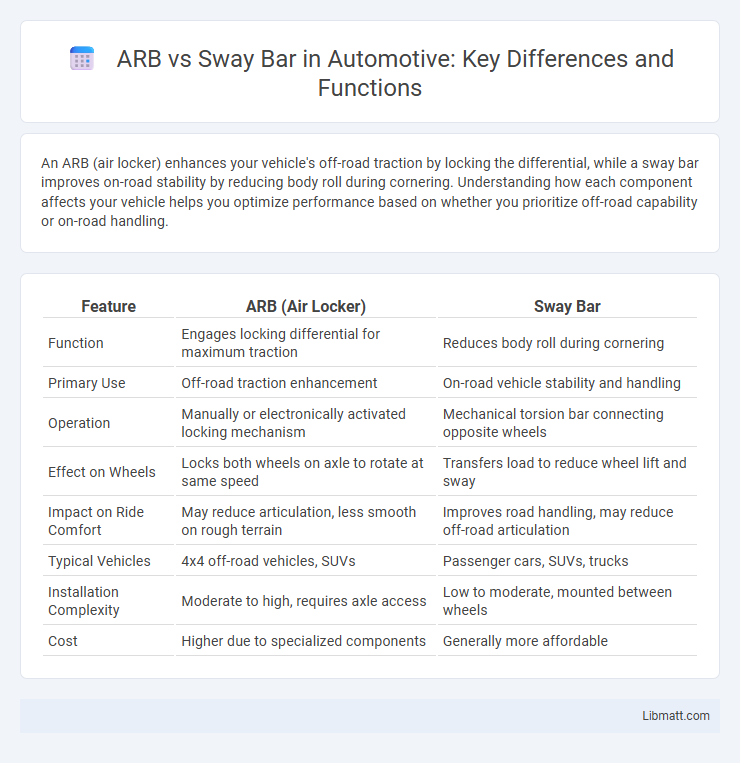An ARB (air locker) enhances your vehicle's off-road traction by locking the differential, while a sway bar improves on-road stability by reducing body roll during cornering. Understanding how each component affects your vehicle helps you optimize performance based on whether you prioritize off-road capability or on-road handling.
Table of Comparison
| Feature | ARB (Air Locker) | Sway Bar |
|---|---|---|
| Function | Engages locking differential for maximum traction | Reduces body roll during cornering |
| Primary Use | Off-road traction enhancement | On-road vehicle stability and handling |
| Operation | Manually or electronically activated locking mechanism | Mechanical torsion bar connecting opposite wheels |
| Effect on Wheels | Locks both wheels on axle to rotate at same speed | Transfers load to reduce wheel lift and sway |
| Impact on Ride Comfort | May reduce articulation, less smooth on rough terrain | Improves road handling, may reduce off-road articulation |
| Typical Vehicles | 4x4 off-road vehicles, SUVs | Passenger cars, SUVs, trucks |
| Installation Complexity | Moderate to high, requires axle access | Low to moderate, mounted between wheels |
| Cost | Higher due to specialized components | Generally more affordable |
Introduction to ARB and Sway Bar
ARB (Air Locker) and sway bar are essential components in vehicle suspension systems, designed for different purposes. ARB refers to an air-actuated locking differential used to enhance off-road traction by locking wheels together, while a sway bar, also known as an anti-roll bar, reduces body roll during cornering to improve stability. Understanding the distinct roles of ARBs and sway bars helps optimize vehicle performance in various driving conditions.
What is an Anti-Roll Bar (ARB)?
An Anti-Roll Bar (ARB) is a torsion spring connecting opposite wheels, designed to reduce vehicle body roll during cornering by distributing weight more evenly across the tires. Unlike a traditional sway bar, the ARB actively tunes suspension stiffness, enhancing stability and grip without compromising ride comfort. Commonly used in performance and off-road vehicles, the ARB improves handling dynamics by limiting chassis lean and maintaining tire contact on uneven surfaces.
What is a Sway Bar?
A sway bar, also known as an anti-roll bar, is a suspension component designed to reduce body roll during cornering by connecting opposite wheels through a torsion spring mechanism. It enhances vehicle stability and handling by distributing weight more evenly, improving grip and control on turns. Your vehicle's sway bar plays a crucial role in maintaining balance, especially during sharp maneuvers or uneven road conditions.
ARB vs Sway Bar: Key Differences
ARB (Air Locking Rear Bar) and sway bar both enhance vehicle stability, but ARB uses an air-actuated locking mechanism for off-road traction while sway bar is a mechanical torsion bar reducing body roll during cornering. ARB allows you to manually disconnect or lock the bar for better articulation and traction on uneven terrain, whereas sway bars remain engaged for consistent on-road performance. Your choice depends on whether you prioritize off-road flexibility with ARB or smooth handling with a traditional sway bar.
Functions of ARBs and Sway Bars
ARB (Active Roll Bars) and sway bars both enhance vehicle stability by controlling body roll during cornering, but their functions differ significantly. ARBs actively adjust stiffness using electronic controls to optimize traction and handling in various driving conditions, while traditional sway bars mechanically link opposite wheels to resist body roll passively. Understanding these roles helps you choose the right suspension upgrade for improved performance and safety.
Benefits of Installing ARBs
Installing an Anti-Roll Bar (ARB) enhances your vehicle's cornering stability by reducing body roll during sharp turns, leading to improved handling and safety. ARBs distribute weight more evenly across tires, increasing traction and minimizing tire wear compared to standard sway bars. This upgrade is essential for off-road enthusiasts and performance drivers seeking optimized suspension response and a smoother ride.
Advantages of Sway Bars
Sway bars enhance vehicle stability by reducing body roll during cornering, improving traction and handling performance. They provide a more predictable steering response and maintain tire contact with the road, which is crucial for safety in dynamic driving situations. The simplicity and lower cost of sway bars make them a practical choice for everyday driving and moderate off-road use.
Common Applications: ARB vs Sway Bar
ARB systems are commonly used in off-road and rugged terrain vehicles to enhance wheel articulation without compromising stability, making them ideal for rock crawling and heavy-duty off-roading. Sway bars, on the other hand, are typically found in street and performance cars to reduce body roll during cornering on paved roads, optimizing on-road handling and comfort. Your choice depends on whether you need maximum off-road flexibility with an ARB or improved on-road stability with a sway bar.
Choosing Between ARB and Sway Bar
Choosing between an ARB (Active Roll Bar) and a traditional sway bar depends on your vehicle's suspension needs and off-road capabilities. ARBs automatically adjust to driving conditions, providing better stability and comfort, while sway bars offer a fixed level of roll resistance ideal for on-road performance. Your choice should consider terrain preferences and handling priorities to optimize vehicle control and safety.
Conclusion: Which is Better for Your Vehicle?
ARB (Air Locker Bar) provides superior off-road performance and locking capabilities ideal for rugged terrains, while sway bars enhance on-road stability and reduce body roll during cornering. Your choice depends on driving conditions: ARBs excel in challenging off-road environments, whereas sway bars improve everyday handling and comfort. Consider your vehicle's primary use to determine which upgrade delivers the best balance of safety and performance.
ARB vs sway bar Infographic

 libmatt.com
libmatt.com